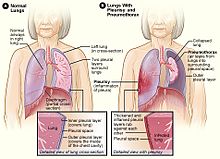
Back التهاب الجنبة Arabic Plevrit Azerbaijani پلورئزی AZB Плеврит Bulgarian Pleuritis Catalan Pliwrisi Welsh Pleuritis German Πλευρίτιδα Greek Pleŭrito Esperanto Pleuritis Spanish
| Pleurisy | |
|---|---|
| Other names | Pleuritis, pleuritic chest pain[1] |
 | |
| Figure A shows normal anatomy. Figure B shows lungs with pleurisy in the right lung, and a pneumothorax of the left lung. | |
| Specialty | Pulmonology |
| Symptoms | Sharp chest pain[1] |
| Causes | Viral infection, bacterial infection, pneumonia, pulmonary embolism[2] |
| Diagnostic method | Chest X-ray, electrocardiogram (ECG), blood tests[3] |
| Differential diagnosis | Pericarditis, heart attack, cholecystitis[3] |
| Treatment | Based on the underlying cause[3] |
| Medication | Paracetamol (acetaminophen), ibuprofen[4] |
Pleurisy, also known as pleuritis, is inflammation of the membranes that surround the lungs and line the chest cavity (pleurae).[1] This can result in a sharp chest pain while breathing.[1] Occasionally the pain may be a constant dull ache.[5] Other symptoms may include shortness of breath, cough, fever, or weight loss, depending on the underlying cause.[5]
Pleurisy can be caused by a variety of conditions, including viral or bacterial infections, autoimmune disorders, and pulmonary embolism. The most common cause is a viral infection.[2] Other causes include bacterial infection, pneumonia, pulmonary embolism, autoimmune disorders, lung cancer, following heart surgery, pancreatitis and asbestosis.[2] Occasionally the cause remains unknown.[2] The underlying mechanism involves the rubbing together of the pleurae instead of smooth gliding.[1] Other conditions that can produce similar symptoms include pericarditis, heart attack, cholecystitis, pulmonary embolism, and pneumothorax.[3] Diagnostic testing may include a chest X-ray, electrocardiogram (ECG), and blood tests.[3][6]
Treatment depends on the underlying cause.[3] Paracetamol (acetaminophen) and ibuprofen may be used to decrease pain.[4] Incentive spirometry may be recommended to encourage larger breaths.[7] About one million people are affected in the United States each year.[7] Descriptions of the condition date from at least as early as 400 BC by Hippocrates.[8]
- ^ a b c d e "What Are Pleurisy and Other Pleural Disorders?". NHLBI. 21 September 2011. Archived from the original on 8 November 2016. Retrieved 1 November 2016.
- ^ a b c d "What Causes Pleurisy and Other Pleural Disorders?". NHLBI. 21 September 2011. Archived from the original on 8 October 2016. Retrieved 1 November 2016.
- ^ a b c d e f Ferri, Fred F. (2016). Ferri's Clinical Advisor 2017: 5 Books in 1. Elsevier Health Sciences. p. 981. ISBN 9780323448383. Archived from the original on 3 November 2016.
- ^ a b "How Are Pleurisy and Other Pleural Disorders Treated?". NHLBI. 21 September 2011. Archived from the original on 3 November 2016. Retrieved 1 November 2016.
- ^ a b "What Are the Signs and Symptoms of Pleurisy and Other Pleural Disorders". NHLBI. 21 September 2011. Archived from the original on 8 October 2016. Retrieved 1 November 2016.
- ^ Kass, SM; Williams, PM; Reamy, BV (1 May 2007). "Pleurisy". American Family Physician. 75 (9): 1357–64. PMID 17508531.
- ^ a b Disease & Drug Consult: Respiratory Disorders. Lippincott Williams & Wilkins. 2012. p. Pleurisy. ISBN 9781451151947. Archived from the original on 3 November 2016.
- ^ Light, Richard W.; Lee, Y. C. Gary (2008). Textbook of Pleural Diseases (2nd ed.). CRC Press. p. 2. ISBN 9780340940174. Archived from the original on 3 November 2016.